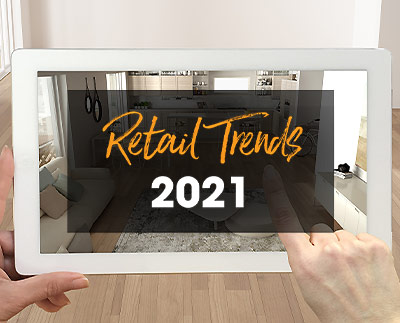
As the calendar pages turn forward to summer and vaccination numbers start to rise, many pundits are talking about the economy and consumer buying behaviour “returning to normal.” The vision is, of course, of everything operating like it did through February 2020.
But the question is, how has what we believed to be normal, pre-pandemic, been forever changed by the experiences of the past year plus? How have lockdowns, remote school, remote work, and living in close quarters evolved everyone’s understanding of what “normal” is?
The home as the hub of the universe
From work, to school, to entertainment, the home has once again become the hub of everyone’s life. With the increase in the amount of time spent within the same four walls, there’s been a corresponding increase in people’s expectations of what those rooms can (and should) be.
- Many more meals were prepared and eaten at home throughout the lockdown. Working lunches and family dinners became the norm for several. Breakfast was no longer something you grabbed on the way out the door, and lunch wasn’t something you bought on-site or with a client. The kitchen saw a great deal more use—and while the re-opening of restaurants will cut down on a portion of that, many eating habits have changed. People found they needed more functionality and/or better aesthetics in a room they suddenly spent more time in.
- The living room is another area that saw an increase in use during the pandemic. People have gotten used to watching the latest movie or binging the latest show on streaming services—as evidenced by the massive increases in subscriber numbers since the pandemic started. With theaters and sporting events shuttered, the living room became synonymous with how folks entertained themselves. For many, this extra time spent together has led them to re-invest in making their living room a more desirable, more comfortable place to be. This rebirth of the living room and the investments made in improving it, combined with only limited re-openings of entertainment options, means that people plan to continue spending time there.
- With students and non-essential workers forced to work and learn from home, the need for a home office was never more evident. Many had previously stuck an old desk in a corner and used it as a place to pay bills from, or to pile things on, without a second thought about using it as intended. That old desk suddenly was a place to operate your business, meet with clients, or to sit in on classroom lessons. The need to update (or in many cases, create) that room was quickly recognized—and acted upon—by people. With many employees expected not to return to office life post-pandemic, and the need for flexibility in case of future outbreaks, offices became one of the most redone spaces of the past year.
- Lastly, bathrooms are another area that people suddenly found themselves paying attention to. When the bathroom is shared by an entire household of people working and learning from home, suddenly its flaws are exposed. People addressed those needs by updating that space to reflect the new usage patterns and improve the look and feel of a room they all used throughout the day, instead of just before and after work.
The increase in time spent in these rooms paired with the increase in expectations of what these rooms can be has driven many to renovate their kitchen, update their living room, finally redo their bathroom, or make that spare room into a true home office. People have made or are planning to make the investment to transform each space into somewhere they want to continue to spend time in, instead of somewhere they have to spend time in.
A DIY expansion
Homeowners like the feeling of remodeling a room they plan to live in—there’s something that feels good about the sense of accomplishment that comes with relaxing in a room you remade.
Since the pandemic, the desire for DIY projects has grown. Some of this was necessary—as the mixing of outsiders into our home, even for just the duration of a project—could have caused the disease to spread. In addition, the desire to undertake DIY projects grew because of a mix of social media, where influencers (and everyday people) showed off their latest designs and makeovers, and popular streaming programs that gave advice on how to reorganize your life or make over your home. Confined homeowners, who suddenly had an increase in free time, saw these projects and quickly responded “why not us?”
Additionally, there’s been a co-construction element of DIY growing in recent years. Co-construction is the idea of collaborating with a designer or working together with a contractor to remake or remodel a room. Many homeowners, emboldened by what they’ve seen online, wanted to collaborate with an expert to design, develop and remodel their own spaces. It’s really an evolution of DIY-related consumer buying behaviour, where the homeowner wants to do it themselves, but also knows their limitations.
There has always been a strong DIY movement among homeowners—and that won’t ever change. But more have discovered their love for remodeling and renovating during the pandemic, and once you’ve had a taste of re-doing a room yourself, and have learned the skills to do so, it becomes less and less likely that you change your behaviour and become uninvolved in future home renovation projects. In fact, success often breeds the desire to do more.
Renovating and redecorating during (and after) a pandemic
With many home improvement shops and showrooms having to close or limit their operations during lockdowns, capacity limits and curfews, the importance of having a solid digital strategy to meet the increased consumer interest and changing consumer buying behaviour was never more evident. Homeowners wanted to update and improve the spaces they were now living and working in 24/7—and the best option open to many was to interact with their preferred retailers/designers/dealers online.
For years, the industry has wrestled with the differences and difficulties inherent in shopping online for what’s needed to redo your home. The difficulty getting consumers into showrooms over the course of the pandemic meant that the traditional browsing behaviour needed to be digitized. Many like to “get a feel” for what they’re installing in their home before they do so; this experience needed to be completely replicated online. This sudden need quickly separated the haves and the have-nots in the world of online furniture and home improvement shopping.
Consumers look for shopping experiences that combine inspiration, convenience and involvement. This desire has not changed despite the shift to digital. In fact, with the move online being exacerbated by the pandemic, studies showed that digital has penetrated age groups that were previously less inclined to shop this way.
With a growing number of consumers now used to the ease of purchasing home improvement items online, it is clear that this channel will remain an important way of doing business, even as showrooms re-open.
What does this mean for specialists, dealers and retailers?
The retailers, specialists and dealers that will continue to win the battle for the hearts and minds of homeowners are those that provide a near hands-on shopping experience that’s immersive, easy-to-use, engaging and gives shoppers more benefits than they’d typically get from visiting a store in-person.
Consumers these days are highly educated as to what they want and how they want it before they ever enter into anything resembling a buying situation. This change in consumer buying behaviour also makes these same folks more difficult to impress. A simple website with thumbnail images of furnishings and potential items to add to a room simply won’t cut it. They are used to instantaneous information and are looking for an interactive and seamless online experience when shopping.
The path to providing something that goes the extra step and stands out among the competition is to embrace the idea of adding extra value through advice and consultation, while keeping the customer journey fun and rewarding. Tools that create a “wow effect” for users—such as high-quality 3D renders, virtual reality and augmented reality—should all be embraced. A virtual showroom and online space planning tools that are optimized for mobile devices will let customers seamlessly work on their projects from any room in the house and eventually in-store, if they choose to visit.
Another way to improve the virtual experience you provide is to enable a connection between professional designers, retailers/dealers and homeowners. By embracing the co-construction and consumer education trends that have increased during the pandemic, these connections, if desired, can help homeowners work together with experts to realize their dream design (or at least one that will better support everyone sharing the same office space every day). A combination of interactivity and technical information improves the process for all.
As restrictions ease, it’s inevitable that consumer buying behaviour will shift again and that some homeowners will return to exclusively shopping for goods in-person. However, with so many experiencing the ease and speed with which they can collaborate with an expert online, try out designs and new looks, and purchase what’s needed, the definition of the word “normal” has changed. Companies that put themselves at the head of this curve will be in the best position to service homeowners both in the short-term as the pandemic comes to an end, and as technologies and preferences around home renovation continue to evolve.
Share this Post




